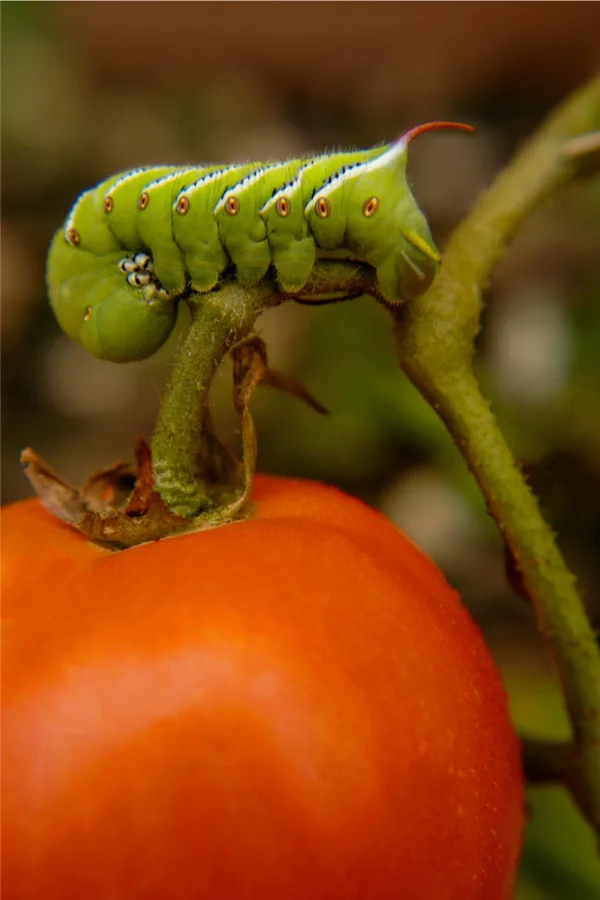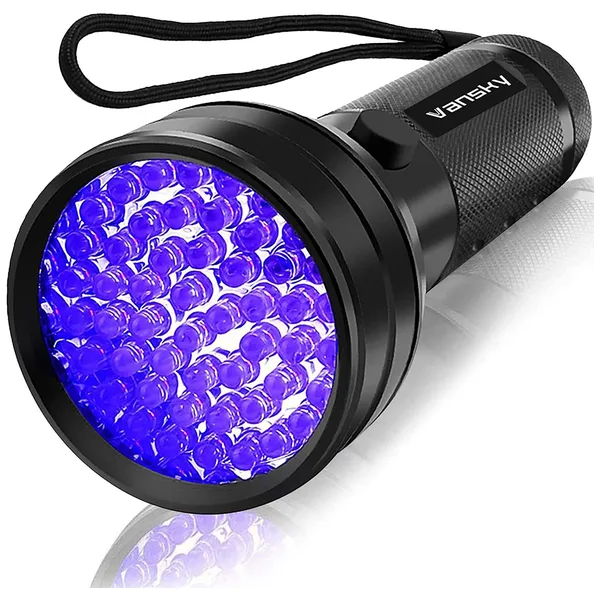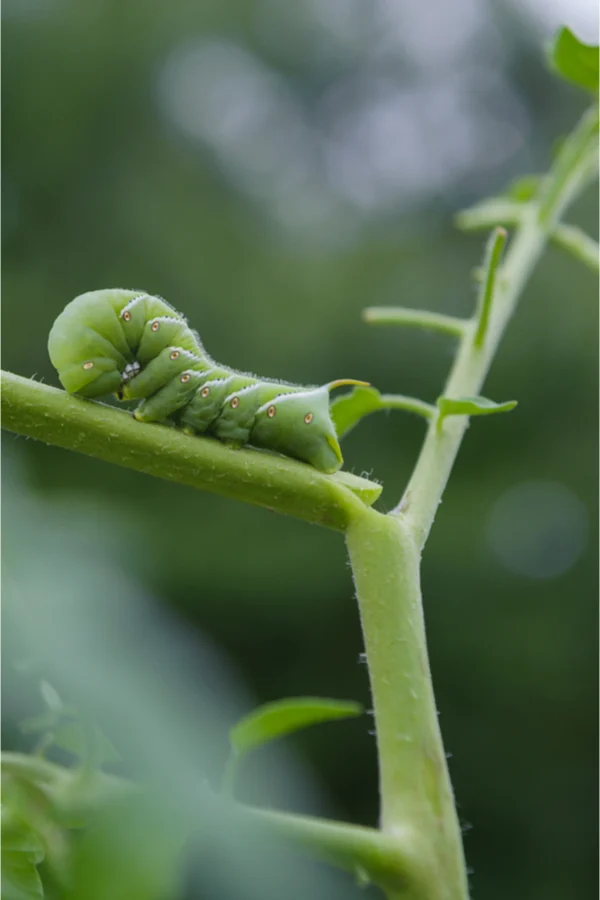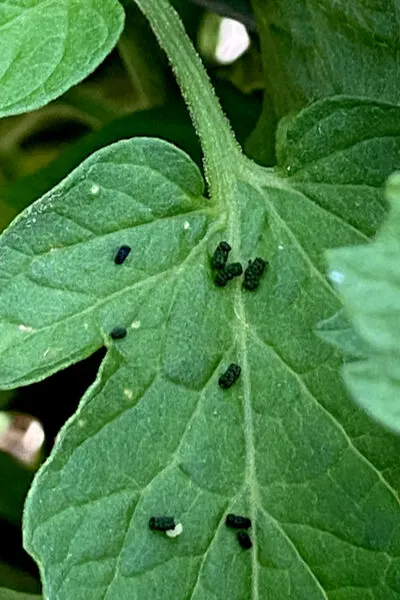Looking for a few tips, tricks and hints to help find the tomato hornworms attacking and destroying your tomato plants?
As summer hits full stride in the garden, the dreaded hornworm becomes quite active. This year has been another big one for hornworm activity in our garden. In fact, they came earlier than ever as we found the first one starting to munch on a tomato plant in mid June!
Hornworms cause extensive damage in quick fashion to the nightshade family of plants. The tender leaves of tomato, pepper, potato and eggplants are the perfect diet for newly hatched worms.

There are actually two types of hornworms – tomato and tobacco. Although they look nearly identical, you can tell the difference between them by the tiny horn upon their head. Tobacco hornworms have a red horn, while a tomato hornworm is a green or slightly black horn.
Unfortunately, whether your garden has tobacco or tomato hornworms – they both love eating your plants! You might even be unlucky enough (as we are) to have both visit your garden!
The Lifecycle of a Hornworm – How To Find Tomato Hornworms With Ease
Hornworms hatch from eggs that are laid early in the season by a moth. The moth is the adult form of the hornworm. The adults fly about, feeding on nectar and laying eggs on host plants (i.e. tomato, pepper and nightshade plants) that can feed the young as they hatch.
They eggs are tiny, green, and nearly impossible to locate and destroy. And when they hatch, the problems begin! As the hornworm gets bigger, so does its appetite. They go from eating a few leaves the first few days, to taking out entire stems and branches as they grow in size.
And do they ever grow fast! A hornworm can go from a tiny, just-hatched half-inch worm, to a four inch long massive creature in just 48 hours. And if left to grow uninterrupted, they can ruin a plant in less than a week.

Making matters worse, as they mature, they don’t just feed on foliage, but also begin to drill into the fruit as well. One thing is for sure, it can cause a lot of frustration for gardeners. Especially when they can see the damage – but can’t seem to locate the culprit!
Stopping Hornworm Damage – How To Find Tomato Hornworms With Ease
Unfortunately, there really is no other method for controlling hornworms besides finding them. In fact, it simply comes down to finding and destroying them before they destroy your plants.
But that can be difficult. Actually, it can be extremely difficult as you can see in the video we included in this article! Hornworms are the masters of camouflage. Whether they are tiny babies or full-grown adults, they blend in as part of the plant with amazing skill.
But the good news is, there are a few little tips and tricks that can help you catch them in the act. One of the secrets works amazingly well in the daylight hours – while the other can help you find and locate them in the dark. Together, they can help keep your plants free and clear of the foraging pest!
How To Find Tomato Hornworms With Ease
The Black Light Flashlight Trick…
If you are experiencing a tomato hornworm attack at the moment and can’t locate the culprits, one of the quickest and easiest methods to find them is by using an inexpensive black light flashlight in your garden at night.
Hornworms have a translucent body that will light up with a black light. The UV rays create a glow on the worms against the plants, making them easy to spot. Simply walk your rows, and shine the light on your foliage. It is amazing to see them light right up! Product Link : UV Blacklight Flashlight

Long Term Control – How To Find Hornworms
More than anything else, diligence is the key to keeping hornworm damage to a minimum. That starts with inspecting your tomato plants each and every day. In fact, in the height of summer, we check our plants twice, once in the morning, and again in the evening.
And just what are we looking for? First and foremost, we are looking for the tell-tale signs of the damage they leave behind. That is most often a complete stem or branch eaten down to a small nub. If you see this, it means you most likely have a larger version lurking somewhere on your plant – and you need to locate and destroy it before the damage gets worse.
Luckily, there is an easy way to find hornworms before they get big – and all it takes is training your eyes to look for the manure or droppings they leave behind!
Locating Hornworm Droppings – How To Find Tomato Hornworms With Ease
One thing is for sure, locating the manure of hornworms is far easier than just searching for hornworms on your plants.
Although hornworms are amazingly adept at blending in, their manure is not! They drop a very distinctive type of manure on leaves as they feed. And fortunately, by eating so much so quickly, they leave a lot of it behind!
Finding Small Hornworms – How To Find Tomato Hornworms With Ease
A young hornworm will leave behind tiny black specs of manure on leaves. They look almost identical to black coffee grounds. The good news is that once you train your eyes to look for the black specs – you will start to be able to spot it quickly. And where there is manure – the young hornworm is certain to be nearby!
The small manure droppings are exactly what you should be looking for as you walk your plants. It will take a bit of practice, but you will get extremely adept at finding the worms within four to six inches of the fresh droppings.
This is THE best way to locate them early. If you were to simply look for them without the aid of a specific area – it would be next to impossible to locate their tiny green bodies. And finding the hornworms when they are young is a huge key to keeping your plants safe.
One to two day old hornworms will begin by feeding on leaves or small stems, and their damage is minimal. But let them get bigger, and the damage mounts quickly!
Finding Larger Hornworms – How To Find Tomato Hornworms With Ease
If the hornworm has grown larger, the droppings will be even larger. Adult hornworm manure will be in the shape of a small sphere or pellet, and be anywhere from 1/8th to 1/4th inch in diameter. When you find adult manure, there are usually stems and leaves that have been devoured nearby as well.
If the manure is green, it is extremely fresh. That means the larger hornworm is probably staring right at you blending in on a branch. If it is darker in color and more dry, the hornworm is still nearby, but expand your eye search to about 1 foot around the manure sighting.
As you look for the pests, keep your eyes peeled more to the upper ends of branches and stems. Hornworms like to navigate to these areas instead of deep into the foliage.
Once you find the droppings and the hornworm, always brush off the manure that is present on the leaves. This way, on your next trip through, you will know any droppings you spot will be a sign a new hornworm is around. – and not spend your time looking for one you already found.
Here is to finding those hornworms – and keeping your plants safe! Happy Gardening, Jim and Mary.
Jim and Mary Competti have been writing gardening, DIY and recipe articles and books for over 15 years from their 46 acre Ohio farm. The two are frequent speakers on all things gardening and love to travel in their spare time.
As always, feel free to email us at thefarm@owgarden.com with comments, questions, or to simply say hello! You can sign up for our free email list in the subscribe now box in the middle of this article. Follow us on Facebook here : OWG Facebook. This article may contain affiliate links.


